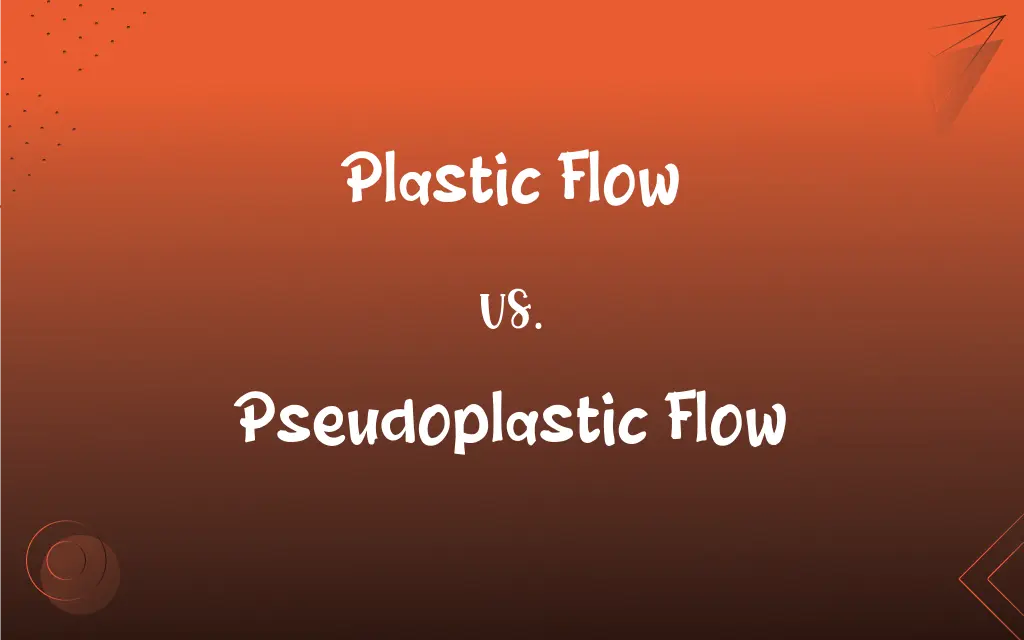Plastic Flow vs. Pseudoplastic Flow: What's the Difference?
Edited by Aimie Carlson || By Janet White || Published on March 2, 2024
Plastic flow occurs when a material deforms permanently under stress after exceeding the yield point, while pseudoplastic flow describes fluids whose viscosity decreases with increasing shear rate.

Key Differences
Plastic flow pertains to the behavior of materials that undergo irreversible deformation when subjected to forces beyond their yield strength. This phenomenon is characteristic of solids, particularly metals and polymers, where the material flows or deforms permanently without fracturing once the applied stress exceeds a certain threshold. Pseudoplastic flow, in contrast, refers to the behavior of certain fluids whose viscosity decreases with an increase in the rate of shear, or the application of force. This type of fluid, often called shear-thinning, exhibits a decrease in resistance to flow as the shear rate increases, making it easier to stir, pump, or spray at higher speeds.
Plastic flow is associated with the permanent deformation of solid materials, pseudoplastic flow describes a reversible change in the flow properties of fluids under varying shear rates. The plastic flow involves the movement of dislocations within the crystal structure of the material, leading to a permanent change in shape. On the other hand, pseudoplastic flow results from the alignment of particles or molecules in the direction of flow, which temporarily reduces internal resistance and viscosity.
Understanding the distinction between plastic and pseudoplastic flow is crucial for engineers and scientists in tailoring materials and fluids for specific applications. For instance, manipulating the plastic flow properties of metals can enhance their ductility and formability, while controlling the pseudoplastic characteristics of fluids can improve their processing and application in various products.
The study of plastic and pseudoplastic flow encompasses a broad range of disciplines, including materials science, fluid mechanics, and chemical engineering. It involves analyzing stress-strain relationships, rheological properties, and the molecular or structural dynamics underpinning the flow behavior. These insights not only contribute to advances in manufacturing and processing technologies but also to the development of new materials and formulations with tailored mechanical and flow properties.
Comparison Chart
Nature
Irreversible deformation of solids.
Reversible decrease in viscosity of fluids with shear rate.
ADVERTISEMENT
Dependency
Stress beyond yield strength.
Shear rate.
Material Types
Metals, polymers, and certain ceramics.
Complex fluids like gels, suspensions, and emulsions.
Behavior Mechanism
Dislocation movement causing permanent deformation.
Alignment of particles or molecules reducing viscosity.
Applications
Material shaping (forging, extrusion).
Improved processing (mixing, pumping, spreading).
Plastic Flow and Pseudoplastic Flow Definitions
Plastic Flow
Permanent deformation under sustained stress.
The bending of a metal rod under force illustrates plastic flow.
ADVERTISEMENT
Pseudoplastic Flow
Fluid viscosity decreases with increasing shear rate.
Ketchup becomes easier to pour out of the bottle due to pseudoplastic flow.
Plastic Flow
Behavior of solids under mechanical stress.
Cold rolling of steel involves plastic flow to reduce thickness.
Pseudoplastic Flow
Shear-thinning behavior observed in complex fluids.
Paint spreads smoothly on a surface because of its pseudoplastic flow properties.
Plastic Flow
Movement of dislocations within a material's structure.
The plastic flow of ductile metals facilitates their use in various industrial applications.
Pseudoplastic Flow
Fluids that exhibit non-Newtonian behavior under stress.
Blood's pseudoplastic flow is essential for efficient circulation.
Plastic Flow
Irreversible material deformation without fracture.
Plastic flow allows for the shaping of polymers in injection molding.
Pseudoplastic Flow
Reversible adjustment of fluid viscosity under shear.
The ease of stirring cornstarch in water is a result of pseudoplastic flow.
Plastic Flow
The flow of material beyond its elastic limit.
Plastic flow is critical in the process of metal forging.
Pseudoplastic Flow
Decreased resistance to flow with applied force.
Lotions exhibit pseudoplastic flow, becoming less viscous when spread.
FAQs
Can pseudoplastic flow be observed in all fluids?
No, it's specific to complex or non-Newtonian fluids.
What is an example of plastic flow in everyday life?
Bending a plastic spoon too far until it deforms.
What characterizes a material's ability to undergo plastic flow?
Its ductility and yield strength.
How is pseudoplastic flow beneficial in industrial applications?
It aids in the processing and handling of fluids by reducing viscosity under shear.
Why do pseudoplastic fluids thin with shear?
Due to the alignment of particles or molecules in the direction of flow.
How does temperature affect plastic flow?
Increasing temperature generally lowers the yield strength, facilitating plastic flow.
Are pseudoplastic fluids always liquids?
They can be liquids or semi-solids like gels.
What role does plastic flow play in manufacturing?
It's essential for shaping and forming materials.
What causes plastic flow in materials?
Stress exceeding the yield point causing dislocation movement.
Is plastic flow reversible?
No, it results in permanent deformation.
What tests measure plastic flow?
Tensile and compression tests on solid materials.
Why is understanding pseudoplastic flow important for product formulation?
It ensures optimal texture, application, and performance of products.
What distinguishes plastic flow from elastic deformation?
Plastic deformation is permanent, while elastic deformation is reversible.
How is pseudoplastic behavior measured?
Through rheological testing to analyze viscosity under different shear rates.
How does the presence of additives affect plastic flow?
Additives can enhance ductility, facilitating plastic flow at lower stresses.
How do engineers utilize knowledge of plastic flow?
To design processes and products that require material deformation.
Can plastic flow occur in brittle materials?
Very rarely, as brittle materials tend to fracture before flowing.
What factors influence pseudoplastic flow?
Temperature, concentration, and molecular structure of the fluid.
Can pseudoplastic flow be predicted mathematically?
Yes, using models that describe shear-thinning behavior.
What implications does pseudoplastic flow have for fluid dynamics?
It affects how fluids move in systems, impacting design and operation.
About Author
Written by
Janet WhiteJanet White has been an esteemed writer and blogger for Difference Wiki. Holding a Master's degree in Science and Medical Journalism from the prestigious Boston University, she has consistently demonstrated her expertise and passion for her field. When she's not immersed in her work, Janet relishes her time exercising, delving into a good book, and cherishing moments with friends and family.
Edited by
Aimie CarlsonAimie Carlson, holding a master's degree in English literature, is a fervent English language enthusiast. She lends her writing talents to Difference Wiki, a prominent website that specializes in comparisons, offering readers insightful analyses that both captivate and inform.
































































